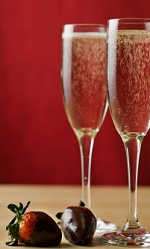chocolate education
Mayan Superfood – Sweet Raw Cacao Nibs
April 11, 2011
Theobroma cacao is the scientific name for Cocoa Beans. After the cocoa beans are harvested, fermented, dried and shipped to the chocolate manufacturer, they are stripped of their outer-most coating, called the shell, and roasted before being ground into chocolate liquor (unsweetened baking chocolate).
These shelled beans are called nibs. Almost all nibs are roasted. Roasting brings out flavor and color development. Roasting also drives off moisture and undesirable “volatiles.”
I wanted to share this brief story about bean processing because RAW nibs are not roasted, and I’d like you to see where they come from and why they stand out even more as a superfood than the already proclaimed superfood-ness (is this a word?) of chocolate.
Read more
Chocolate Tempering: Crystal Sizes
April 1, 2011
Once people understand that chocolate tempering is the secret to getting great results for their own chocolate creations, I get a lot of related questions.
Here's a conversation with a student at a live, in-person session where I was talking about the crystal sizes, within the cocoa butter, for proper tempering.
Read more
Chocolate Dipped Strawberries and Champagne
February 17, 2011
When you put a fresh strawberry into the bottom of a champagne glass and then pour the champagne, just watch the bubbles fly off the strawberry at a record rate of speed!
The strawberry gives more surface area from which to produce bubbles. For this reason alone, a strawberry in champagne is very romantic. And let’s not forget that a champagne soaked strawberry is oh-so-delicious!

Read more
The Power of Cocoa Powder
February 15, 2011
New research finding just released in the Chemistry Central Journal compares the antioxidant power of the powders; fruit powder vs. cocoa powder.
Cacao and a number of other fruits are often classified as super fruits. So which is the most super?
In the study, a variety of fruit powders were analyzed for their antioxidant capacity (ORAC) and total flavanol (TF) content. Cocoa powder was also analyzed.
After all the powders were tested, it was determined that cocoa powder had the most concentrated source of antioxidants and flavanols (ORAC and TF).
Read more
Chocolate Tasting Interview
February 10, 2011
A few weeks ago I was interviewed for an article with the Milwaukee Journal Sentinel newspaper. That article appeared in the print version yesterday and online the day before.
There's some great information about tasting chocolate as well as pairing chocolate and wine. Click this link for the full chocolate and wine article.
Read more
Chocolate and Cocoa Substitutes
January 28, 2011
Have you ever discovered you were out of an ingredient? Of course that always seems to happen right in the middle of making something!
When the recipe calls for chocolate, cocoa powder, or unsweetened baking chocolate, using the correct substitution can mean your crisis is avoided. And no emergency trip to the grocery store!
Read more
Wax in Your Chocolate?
January 13, 2011
No, do not add wax to your chocolate!
It seems like I give tempering advice all the time. And I know why. Tempering chocolate should be easy, but it isn’t. And when struggling, people do one of two things: seek advice or look for ways to cheat.
Tempering is just one of those things that takes a lot of practice, and you have to be willing to learn from your mistakes.
If you are making chocolate-dipped candies and have trouble with the tempering process, you may be tempted to put paraffin or baker's wax into your coating to help it set.
Read more
Chocolate Dipped Spoons
December 18, 2010
If you are creative and crafty (as in talented in making crafts, not as in clever with intent to do evil) this may be the project for you. Spoons dipped in chocolate can make an impressive gift!
Before I get into the project, I would like to define some terminology for you.
couverture coating - this is a professional-quality chocolate coating that contains a high percentage of cocoa butter, allowing the chocolate to form a thinner coating shell than other chocolate.
Read more
Chocolate in the Freezer?
December 17, 2010
A question I hear somewhat frequently is, "Should I store chocolate in the freezer?"
A friend once told me that the best place to store chocolate is in your mouth. 🙂
Now for a more serious answer, the best place to store chocolate is in an odor-free, air-tight container surrounded by a 65 to 68 F air temperature with no more than 50% relative humidity. How’s that for precise?
Read more

